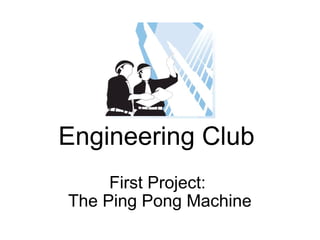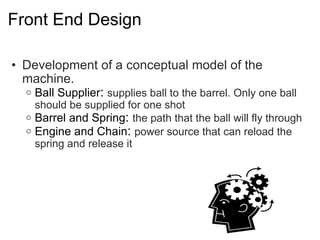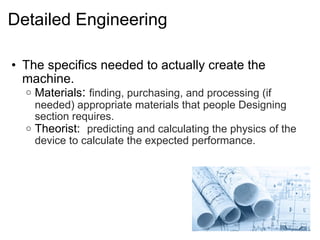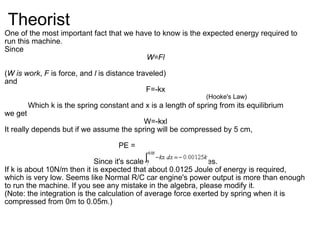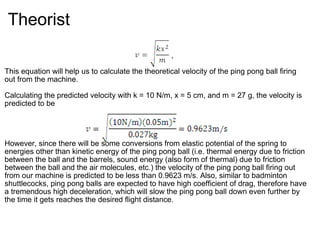Ping pong machine_design
- 1. Engineering Club First Project:┬Ā The Ping Pong Machine
- 2. Front End Design Development of a conceptual model of the machine. Ball Supplier :┬Ā supplies ball to the barrel. Only one ball should be supplied for one shot Barrel and Spring :┬Ā the path that the ball will fly through Engine and Chain :┬Ā power source that can reload the spring and release it
- 3. Ball Supplier The table tennis ball goes on the left hand side of the barrel, and the spring goes on the right end. As the spring is compressed, the plastic board┬Ā(white) will open up with the barrel so that one ball is dropped into the barrel, then closes as the spring compresses further. The barrel design itself is┬Āsimplified.
- 4. Barrel and Spring Initial design of barrel and spring by Chiu IŌĆÖHsuan and Pratik Sharma
- 5. Barrel and Spring Design #2 through google sketchup. We can cut the PVC pipe and glue four plane plates under it. Although both ends are open in this diagram, one side of it has to be closed. So, in this barrel, the ping pong ball will be inserted to the top semi-circular hole of the barrel. The spring will be reloaded by the bump that is going to move through the central groove (circled red in this diagram) by motor and chain. This is (Lawrence)'s Idea and please make any modification if you have better idea
- 6. Barrel and Spring ŌĆ£ Hop-up" system in the air soft gun: ItŌĆÖs basically putting a spin in the ball by placing a bump in the barrel. This could be applied to our machine. By making a "Variable" hop-up (maybe made by rubber?) we can control the spin and our machine can then perform with more functions! so lets think about this idea too. ┬Ā The hop up system will definitely be useful, we can just add a rotating pipe joint, with a piece of rubber attached in its interior side, in front of the barrel to create different types of spins, including backspin which is the hop up. ┬Ā
- 8. Detailed Engineering The specifics needed to actually create the machine.┬Ā Materials :┬Ā finding, purchasing, and processing (if needed) appropriate materials that people Designing section requires. ┬Ā Theorist:┬Ā ┬Ā predicting and calculating the physics of the device to calculate the expected performance.┬Ā
- 9. Material ┬Ā PVC should be our main material ┬Ā ┬Ā - PVC is mainly used for construction for its cheapness, durability, and its easy to work with.┬Ā On Youtube, there are many videos and tutorials about making air soft guns, with PVC, which means that it should be durable enough to withstand our purposes.┬Ā Some other materials:┬Ā Spring, Cement(Super glue)/Hot glue,Chains(Chui's?), and Motor(Chui's?) possible places we can acquire these materials are:┬Ā ┬Ā ┬Ā - Homepro ┬Ā ┬Ā - Big C┬Ā ┬Ā ┬Ā - home Works┬Ā ┬Ā ┬Ā - Maybe Office Depot(not sure)┬Ā ┬Ā ┬Ā
- 10. Theorist One of the most important fact that we have to know is the expected┬Āenergy required to run this machine. Since W=Fl ┬Ā ( W is work , F is force, and l is distance traveled) and F=-kx Which k is the spring constant and x is a length of spring from its equilibrium we get W=-kxl It really depends but if we assume the spring will be compressed by┬Ā5 cm, ┬Ā ┬Ā ┬Ā ┬Ā ┬Ā ┬Ā ┬Ā ┬Ā ┬Ā ┬Ā ┬Ā ┬Ā ┬Ā ┬Ā ┬Ā ┬Ā ┬Ā ┬Ā ┬Ā ┬Ā ┬Ā ┬Ā ┬Ā ┬Ā ┬Ā ┬Ā ┬Ā PE = Since it's scaler, its 0.00125k Joules. If k is about 10N/m then it is expected that about 0.0125 Joule of energy is required, which is very low. Seems like Normal R/C car engine's power output is more than enough to run the machine. If you see any mistake in the algebra, please modify it. (Note: the integration is the calculation of average force exerted by spring when it is compressed from 0m to 0.05m.) (Hooke's Law)
- 11. Theorist Now, relating it to the conservation of energy, we can estimate the launch velocity of the ping pong ball. In the previous page, we have proven that the elastic potential of a spring compressed by x meters is, ┬Ā┬Ā┬Ā┬Ā┬Ā┬Ā┬Ā┬Ā┬Ā┬Ā┬Ā┬Ā┬Ā┬Ā┬Ā┬Ā┬Ā , where the k represents spring constant and c is a constant. General equation for finding the kinetic energy of object of mass m kg moving at the velocity v m/s is, ┬Ā ┬Ā ┬Ā ┬Ā ┬Ā ┬Ā ┬Ā ┬Ā , Theoretically, all of the elastic potential energy will be transferred to the kinetic energy of the ping pong ball in our machine. Hence we can calculate the expected velocity of the ping pong ball shooting out of our machine as the following:
- 12. Theorist ┬Ā ┬Ā ┬Ā ┬Ā ┬Ā ┬Ā ┬Ā ┬Ā , This equation will help us to calculate the theoretical velocity of the ping pong ball firing out from the machine. Calculating the predicted velocity with k = 10 N/m, x = 5 cm, and m = 27 g, the velocity is predicted to be ┬Ā ┬Ā ┬Ā ┬Ā ┬Ā ┬Ā ┬Ā ┬Ā┬Ā However, since there will be some conversions from elastic potential of the spring to energies other than kinetic energy of the ping pong ball (i.e. thermal energy due to friction between the ball and the barrels, sound energy (also form of thermal) due to friction between the ball and the air molecules, etc.) the velocity of the ping pong ball firing out from our machine is predicted to be less than 0.9623 m/s. Also, similar to badminton shuttlecocks, ping pong balls are expected to have high coefficient of drag, therefore have a tremendous high deceleration, which will slow the ping pong ball down even further by the time it gets reaches the desired flight distance.
